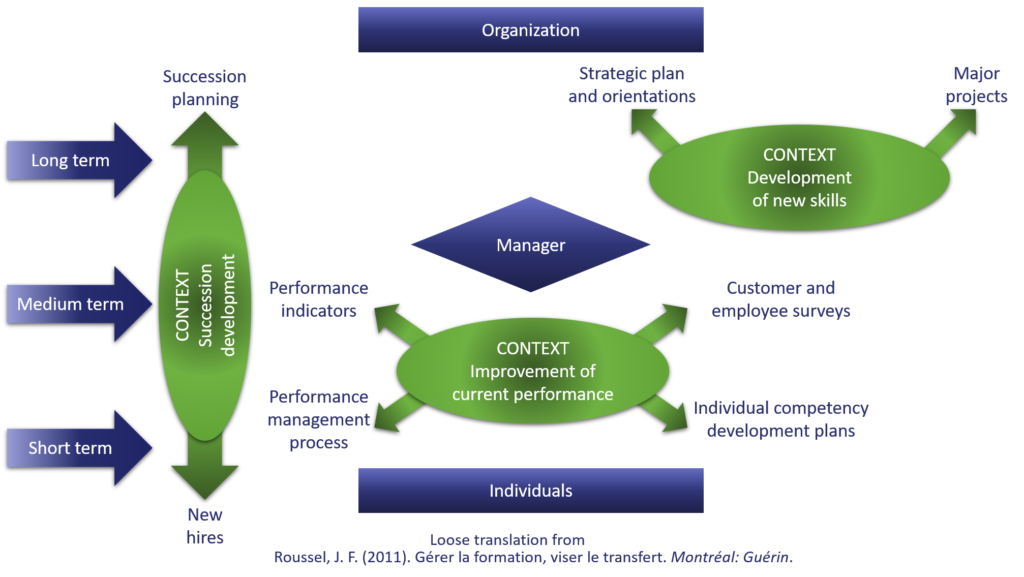Adopting a Strategic Approach to Learning

By Sophie Lanoix
Have you ever wondered if you are getting the most out of your training efforts and expenses? Are you tired of …
- being reactive to training requests?
- spending money on training that does not impact your organizational performance?
- losing contracts or customers because your employees do not have the skills you need now and in the future?
How about taking a strategic approach to learning? You could transform the efforts and resources invested in training into real learning and growth for your organization. Training would become a strategic lever for your organization, and you would be in a better position to achieve your strategic organizational objectives.
“The ability to learn faster than competitors may be the only sustainable competitive advantage.”
Arie De Geus
Don’t know where to start? Unfortunately, there is no such thing as a miracle recipe. Each organization must implement measures adapted to its internal and external context. However, to help you get started, here are some avenues of action.
1. Stop wasting money on training that doesn’t work!
Organizations waste a lot of money on training, and for two reasons:
- because they do training even when they don’t need it
- because the training they provide to their employees is not effective
Here’s how you can easily fix this problem and increase the return on your training investments.
Organize Training Only When it is the RIGHT Solution to a Problem
Before designing or organizing training, it is important to ask yourself if the performance problem you are trying to solve is really due to a lack of knowledge, skills or competencies. In many cases, this is not the case. Here are questions you can ask to find the cause of a performance problem:
Do the employees …
- have the tools to do the job?
- know what standards they must meet?
- receive feedback on their performance?
- are rewarded or punished for good behaviour?
- want to do the task?
- have the physical or mental ability to do the task?
If you answer NO to any of these questions, training will not be the first solution to your problem.
However, you can implement the training if you answer NO to the following question:
Do employees have the knowledge and skills required to do the job?
In short, the only situation in which a performance problem can be solved by a classroom course, a virtual classroom or an online course, is if employees do not have the knowledge or skills required to do the job.
Organizing or designing training for any other reason is just wasting resources.
Ensure That the Training Design is Effective
Now that you know that training is the solution to your performance problem, will all training solve the problem? Not necessarily. To be effective, training must be well designed. Make sure that the training:
- is available when learners need it, not six months in advance
- be as participatory as possible
- focuses on what the employee needs to do, back in the workplace and not on a mountain of things good to know
- responds to the perceived need of learners—explain to learners why this training or skill will be useful to them
- is directly related to the learner’s work and that they can apply their new skills in a real work project
- is only available to employees who need it, otherwise it is a waste of time for others
2. Analyze Learning Needs Over 360o
Many organizations rely on the ad hoc needs of employees and expressed by managers to make their annual training plan. Although it is necessary to take these into account, a plan based solely on those learning needs is incomplete and reactive.
In order for the training plan to contribute to your organization’s priorities, it is also necessary to take into account the related training needs:
- strategic objectives and major projects
- succession needs
- the results of customer surveys
- the results of performance indicators
Once you have identified the learning needs, you can write a comprehensive training plan that will truly contribute to the success of the organization. For each training session, you should be able to answer the following questions:
- Who will be trained? — Who really needs this training?
- On what? — What is the skill or ability to be developed?
- Why? — What problem are you trying to solve with this training?
- How? — Which training methodology is most appropriate?
- When? — When do the target employees need training?
3. Develop an Organizational Learning Strategy
Survey colleagues and you will see: very few organizations are mature enough to have an organizational learning strategy in place. However, it is a simple document that can have a significant impact on the organization. A learning strategy includes, among other things:
For example…
- your commitment to learning
ACME Inc. is committed to the training, development and continuous improvement of all members of the organization, to ensure that everyone is prepared to meet the current and future challenges of our organization.
- the principles that guide for your training decisions
- Learning initiatives are focused on developing skills that enable people to perform to the best of their abilities
- Learning initiatives are designed using to the competency-based approach and not a content approach
- Training methods are selected based on the optimization of learning and the use of resources and not based on the requester’s preference or the simple availability of technology
- Etc.
- the roles and responsibilities of each person with regard to training and learning
List the responsibilities of the key learning actors in the organization, such as:
- Senior management
- Training or human resources team
- Managers
- Employees
With a learning strategy in hand, your training and learning decisions will be consistent with each other and over time. All the actors will know their role, and it will be easier for you to get the necessary budgets to implement your training plan.
4. Become a Learning Organization
For several years, there has been a lot of talk about learning organizations and the importance of developing a positive learning culture. Take a few seconds to think: what does your organizational culture look like? How do you experience learning in your organization? Are you learning from your successes? What about your mistakes? How do you encourage learning? Changing an organizational culture takes time, but it can be done.
Here are three concrete actions you can take now that will help you move forward on the path to a positive learning culture.
1. Plan the transfer of learning
Each time a person participates in training, they should have a conversation with their supervisor to determine:
- expectations for behavioural changes following training
- the opportunities to practise the skill or ability after the training
- the support they have access to in order to apply the skill or ability
- their margin of error when practicing the new skills or ability
2. Have pilots and prototypes
When you set up a new training program or use a new training methodology, have a pilot courses and prototypes. Testing with members of your target audience will allow you to make adjustments and ensure that the training really meets the needs of the learners and the organization.
3. Learn from Your Experience
Have post-mortem for your projects, including your training projects. Once you have identified good moves and mistakes, adjust your ways of doing things and procedures to improve and avoid repeating mistakes. Sounds simple, doesn’t it? You would be surprised to learn how many organizations never do post-mortems or, when they do, do not take appropriate action to address their findings.
5. Identify a Learning Leader
Do you have a Chief Financial Officer and a Chief Operating Officer? A head of learning is just as important. In large organizations, this learning leader may be in a management position. In small organizations, it can be the human resources manager or even an advisor.
The important thing is that there is someone who has a global vision of what is happening in the learning process in the organization and who is responsible for monitoring the performance indicators you have identified for training. Normally, this person is also the one who will have written the learning strategy and training plan. If this person does not hold a managerial or executive position, he or she should at least maintain a close relationship with the organization’s decision makers.
Conclusion
As you can see, taking a strategic approach to training is a long-term process. Each organization is different and your path to get there will be different from that of another.
Like all major projects, this can be achieved by taking one concrete step at a time and targeting actions in the short, medium and long term. Are there any other actions or paths than those described here? Certainly! But if you are thinking about it for the first time or on the contrary, for a long time without knowing where to start, you have here some ideas to start your adventure.
We have created a colorful infographics that you can use as a reminder of the actions described in this article.
Download the infographics
Do you have any questions, comments or reactions? Feel free to share them with us in the forum below.
Hesitating? You can write to us in private.
Need a hand to get started?
We can help you.
Spread the word!
Facebook-f
Twitter
Linkedin-in
Instagram
Envelope
References
Bowles, M. (2013). Lead learning strategy implementation. Launceston: Institute for Working Futures.
De Geus, A. P. (1988). Planning as learning(pp. 70-74). March/April: Harvard Business Review.
Gilbert, T. (1996). Human competence: Engineering Worthy Performance, Tribute Edition. Silver Spring, Md.: International Society for Performance Improvement.
Roussel, J. (2011). Gérer la formation, viser le transfert. Montréal: Guérin, éditeur ltée.
Senge, P. (2006). The fifth discipline. London: Random House Business.


